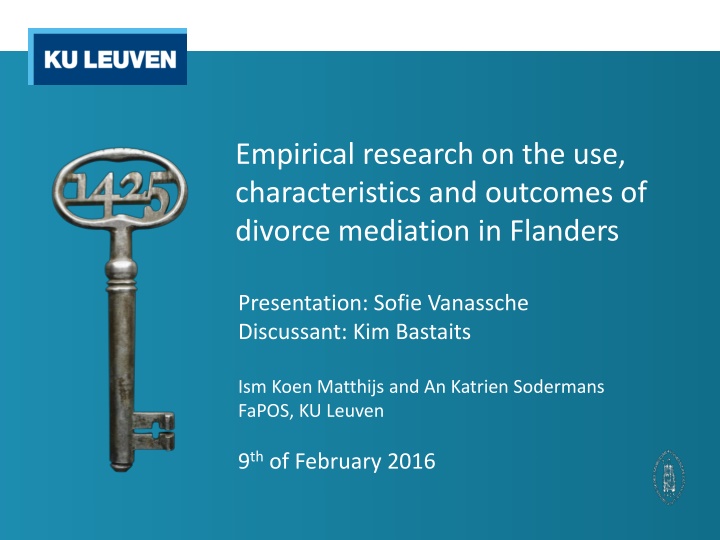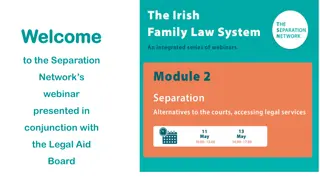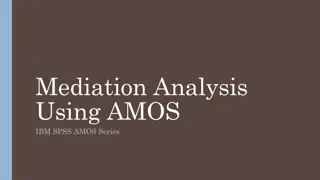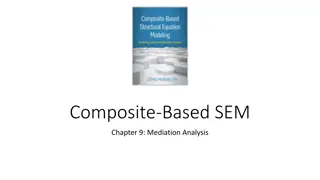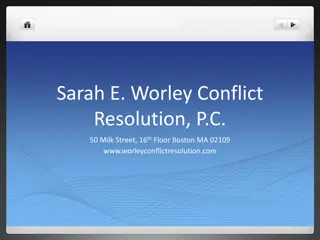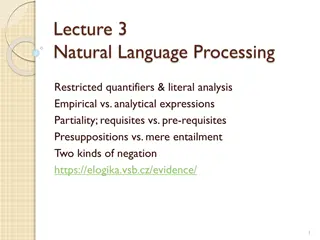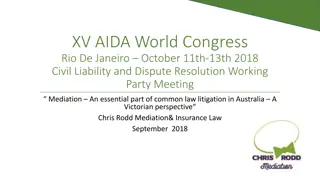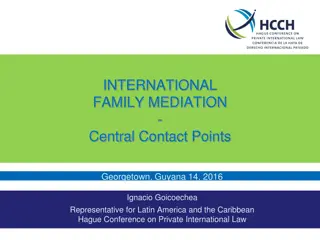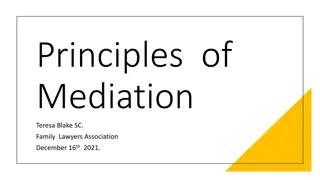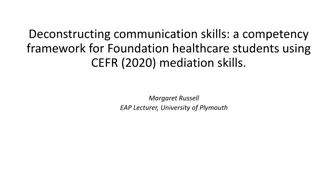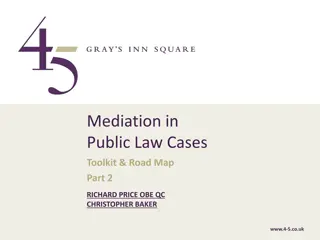Empirical Research on Divorce Mediation in Flanders: Characteristics and Outcomes
This presentation explores the use, characteristics, and outcomes of divorce mediation in Flanders, focusing on the macro-sociological context, contemporary family dynamics, and implications of union dissolution. Key themes include individualization, reflexivity in relationships, child-centered family dynamics, and the challenges of enduring conflicts post-divorce. The research highlights the impact of divorce on family members and society at large, shedding light on negotiated family arrangements and emerging trends in family structures.
Download Presentation

Please find below an Image/Link to download the presentation.
The content on the website is provided AS IS for your information and personal use only. It may not be sold, licensed, or shared on other websites without obtaining consent from the author.If you encounter any issues during the download, it is possible that the publisher has removed the file from their server.
You are allowed to download the files provided on this website for personal or commercial use, subject to the condition that they are used lawfully. All files are the property of their respective owners.
The content on the website is provided AS IS for your information and personal use only. It may not be sold, licensed, or shared on other websites without obtaining consent from the author.
E N D
Presentation Transcript
Empirical research on the use, characteristics and outcomes of divorce mediation in Flanders Presentation: Sofie Vanassche Discussant: Kim Bastaits Ism Koen Matthijs and An Katrien Sodermans FaPOS, KU Leuven 9thof February 2016
Structure Introduction: macro-sociological context of divorce mediation Data source: Divorce in Flanders A selection of research findings o Part 1 Discussion o Part 2 Discussion o Part 3 Discussion
Introduction The macro-sociological context of divorce mediation
The contemporary family: Beck & Giddens Individualisation & secularisation: o Interests of individual family members > social commitments, family as a whole o Individual desires > roles defined by law, religion or tradition Pure relationships: o Love as reason for partnerhips and union dissolutions o Relationships part of self-discovery, self-identity, self-realization o Reflexivity and responsibility of individual regarding the risks and rewards of union The negotiated family: o From patriarchal model (unequal and oppressive) to gender equality o Communication: as family roles are no longer fixed, each member s role and responsibility needs to be negotiated
The contemporary family: child-centrered Children s interests are high(est) priority High parenting standards Agency of the child Large increase in father involvement Parent-child relationship is unconditional (e.g. joint custody) New challenges for relationship between ex-partners with children
The contemporary family: union dissolution Almost one on two unions are dissolved Union dissolution is a proces with a large impact on all family members: emotionally, socially, financially, Enduring conflicts have been identified as one of the main causes for long-lasting, negative consequences of union dissolution Next to individual consequences, also costs for broader society: juridical costs, medical costs , social costs, Educational gradient in union dissolution and family processes Negotiated family middle- and upper-class phenomenum? o Spillover of divorce costs? o
Juridical developments (Belgium) Facilitation/democratisation of union dissolution, e.g. shorter procedures, focus on agreement between ex-partners Reduction of guilt (no-fault divorce): introduction of divorce based upon irretrievable disruption (EOO) in 2007 Introduction of divorce mediation in family law: 2001: Judge can appoint mediator o 2005: Legal principals of mediation + federal mediation commission o 2007: Information duty Judge o 2014: Family courts: space for amicable settlement o Discussion on wether or not a first introduction to mediation needs to be imposed
Aims of the present study (1) 1. Who knows professional divorce mediation and how? Increase over time (e.g. divorce law)? Social gradient in (access to) information? 2. Who uses professional divorce mediation? - What are reasons not to use divorce mediation? - Who took the initiative? Is there a social gradient in the use of mediation as an attempt to reduce the conflict associated with a union dissolution? 3. What are the dominant pratices in divorce mediation in terms of timing and duration of the mediation and the professional background of the mediator?
Aims of the present study (2) 4. Are children involved in the mediation? Acknowledgement of children s agency? 5. How often does the mediation result in an agreement and what are predictors? Social gradient? Role of power inbalance, e.g. higher educated partner? 6. How satisfied are people with the mediation and what are predictors of their satisfaction? How important is it to end the mediation with an agreement? 7. What are the outcomes of mediation for the divorce proces? Are divorcees more satisfied with the divorce proced if they used mediation?
Divorce in Flanders data Who? What? How?
Divorce in Flanders SiV-consortium Prof. Mortelmans (Universiteit Antwerpen, Centrum voor Longitudinaal en Levensloop Onderzoek) Prof. Van Bavel (Vrije Universiteit Brussel, Interface Demography + Katholieke Universiteit Leuven, Family and Population Studies) Prof. Bracke (Universiteit Gent, Health and Demographic Research) Prof. Matthijs (Katholieke Universiteit Leuven, Family and Population Studies) Mevr. Van Peer (Studiedienst Vlaamse Regering) Books Scheiding in Vlaanderen (Acco, 2011) Scheiden in Meervoud (Acco, 2013) Website: www.scheidinginvlaanderen.be
Sample Reference marriages as sample unit: 2 partners, man and woman... With Belgian nationality and living in Flemisch Region Married between 1970 en 2008 for the first time When they were between 18 and 40 years old And who were not divorced more then once. Of those references marriages: 1/3 married and 2/3 divorced in 2010 Multi-actor design: Both (ex partners), a child, a parent and new partner (if any) Realized sample: 3.502 dissolved marriages 979 intact marriages Research sample: In case both partners participated, random selection of one partner
Results part 1: Knowledge and use
Who knows divorce mediation? (%) Married Divorced Total 57 63 Low educational level Average educational level High educational level Man Woman 39 50 68 55 57 47 60 79 64 63 Divorced before 2007 Divorced since 2007 63 67
How did respondent learn to know mediation? (%) Married Divorced Notary Laywer 3 3 7 8 Judge CAW, OCMW 1 5 3 4 Internet, newspaper or tv Partner, family, friends, 66 42 49 35 Other 18 14
Who visited a mediator? % 11 7 8 17 7 12 6 6 9 13 14 % 12 7 9 10 13 5 23 8 12 Total Low educational level Average educational level High educational level No children Children Divorced between 1970 - 1990 Divorced between 1990 - 1995 Divorced between 1995 - 2000 Divorced between 2000 -2005 Divorced between 2005 -2010 No new partner New partner Few conflict Average conflict Lot of conflict Never professional help Other professional help No housing Houding
Reasons not to use mediation Question asked to 10% of people who thought of visiting a meditator but finally did not do so. (%) Financial reason No mediator in neigbourhood My partner did not want to go We wanted to obtain an agreement ourselves I had a preference for other professional help I was worried about the opinion of others Other reason Divorced 6 2 65 15 4 1 12
Discussion: Knowledge and use The information duty of judges does not work as a strategy to increase the information on the existence of divorce mediation The large distance between the knowledge and use of mediation suggests that many persons are not open for mediation Divorce mediation is an upper-class phenomenum and will reinforce social differences in the outcomes of divorce
Results part 2: The characteristics of divorce mediation
Who took the initiative? (%) Man Woman Me My partner 34 23 62 11 Both 43 23 Laywer or Judge Other 0 0 2 2
What is the professional background of the mediators that are visited? (%) Man Woman Totaal Laywer 16 17 33 Notary 14 4 18 Other 19 30 49 Total 49 51 100
Did mediator hear the children? (%) Laywer Notary Other n No Yes, via neutral 3rd person 79 6 87 6 81 8 248 21 Yes, him/herselve 15 7 11 36 Chi-Square=2.63, df=4, p=0.62 (%) Men Woman No Yes, via neutral 3rd person 78 84 8 6 Yes, him/herselve 14 10 Chi-Square=1.66, df=2, p= 0.44
Timing Laywer Notary Other n Only before legal divorce 78% 83% 88% 312 Only after legal divorce 2% 3% 2% 8 Both before & after legal divorce 21% 14% 9% 50 Chi-Square=8.45, df=4, p=0.08 Frequency of conflict during divorce proces (0-10) Only before legal divorce 5,5 Only after legal divorce 6,7 Both before & after legal divorce 7,1 F = 4.51, df=2, p=0,01
Duration: number of sessions Number of sessions 1 2 3 4 5 6 7 8 9 10 12 13 15 20 40 or more n 74 62 60 41 40 19 7 14 2 22 4 1 2 4 6 % Predictors: Notary fewest sessions Parents more sessions 20,7% 17,3% 16,8% 11,5% 11,2% 5,3% 2,0% 3,9% 0,6% 6,2% 1,1% 0,3% 0,6% 1,1% 1,8%
Discussion: mediation procedure Divorce mediation is currently too much focused on divorce as a single event, that is regulating the official divorce. More attention is needed for conflict resolution after the divorce procedure Mediatiors too often ignore the agency of children
Results part 3: The outcomes of divorce mediation
Was there an agreement? n % Yes, full agreement 144 39 Yes, partial agreement 37 10 No 192 51 Predictors: Both partners took initiative Mediator was notary Between 4 and 9 sessions Few conflict
Satisfaction with agreement? (%) n % (Completely) unsatisfied 27 15 Neutral 26 14 (Completely) satisfied 128 71
Satisfaction with mediation (%) N % 80 22 (Completely) unsatisfied Neutral 87 23 (Completely) satisfied 206 55 Predictors: Having obtained an agreement Taking initiative (not the ex-partner)
Discussion: outcomes of mediation The outcomes of divorce mediation are limited by the focus on obtaining an agreement Divorce mediation fails if it does not reduce the amount of conflict between the ex-partners The importance of joint initiative for obtaing an agreement and being satisfied with the mediation is an argument against directing people towards mediation
Marriage cohorte X divorce cohort Divorce cohort 1970-1979 (%) 1980-1989 (%) 1990-1999 (%) 2000-2010 (%) Totaal (%) 90% 1970-1979 (%) 39 200 325 256 820 (25%) 60% Marriage cohort 1980-1989 (%) 102 547 695 1.344 (41%) 1990-1999 (%) 267 783 1.050 (32%) 2000-2010 (%) 212 212 (7%) Totaal (%) 39 (1%) 302 (9%) 1.139 (35%) 1.946 (60%) 3.426 (100%)
